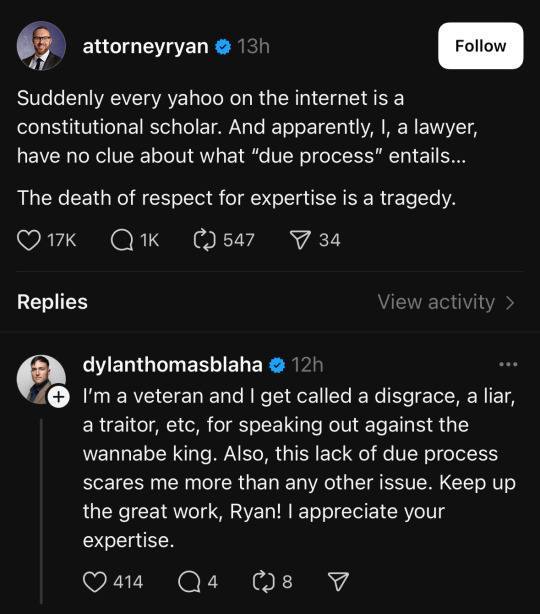#EXPERTS
Explore tagged Tumblr posts
Text

“If I could, I would erase from my mind every one of the results that our research team uncovered. It’s just…I…I just don’t have it in me to say what we concluded. For your sake, I think we’ll keep that to ourselves. Excuse me.” A teary-eyed Hart then reportedly walked off stage, called his wife and daughter, and told them he loved them very, very much.
Full Story
642 notes
·
View notes
Text

#pay attention#educate yourselves#educate yourself#knowledge is power#reeducate yourself#reeducate yourselves#think about it#think for yourselves#think for yourself#do your homework#do your own research#do your research#do some research#ask yourself questions#question everything#conspiracy theorists#pattern recognition#experts
472 notes
·
View notes
Text

This is exactly what the FDA and CDC look like behind the scenes, as they scramble data between one presser and the next. Yet it’s not just the “experts” who are the problem.

253 notes
·
View notes
Text

Topps Chewing Gum Inc, 1978
#Smooooth n' Juicy#ad#1978#bubble gum#Bazooka#advertisement#1970s#illustration#experts#70s ads#vintage#advertising
98 notes
·
View notes
Text

#experts#education#university#law degree#lawyers#attorney#attorneys#politics#political#us politics#news#donald trump#american politics#president trump#elon musk#jd vance#law#veterans#vets#republicans#democrats#democracy#america#us news#trump administration#elon#maga#american#republican#president donald trump
125 notes
·
View notes
Text
by Seth Mandel
The propaganda campaigns against Israel rely on an industry of manufactured “expertise.” Without the ability to appeal to the authority of such “experts,” the campaigns collapse. For anyone who’s been paying attention in the past few days, the collapse is everywhere you look.
First there was the Sky News anchor hectoring Israeli Ambassador Danny Danon over Israel’s strike on a tunnel system beneath a Gaza hospital to eliminate senior Hamas officials, notably its de facto leader Muhammad Sinwar, brother of Oct. 7 architect Yahya Sinwar. The anchor insisted Israel was wrong to say there were tunnels underneath the hospital and surrounding area because “our experts”—a phrase she repeated in the vain hopes it would sound convincing—said so.
You’ll never guess what happened next. That’s right—Hamas confirmed that the targeted area was indeed the site of a tunnel system, and added more context. It was, Hamas said, destroyed by the IDF in the 2014 Gaza war and since rebuilt. It was there that Israel attempted to take out Sinwar.
Then yesterday, along with reports of another Sinwar’s elimination (Mohammad’s brother Zakaria) came reports that Muhammad Sinwar’s body was indeed found in the tunnel system targeted by the IDF.
Who are Sky News’s “experts”? One of them is Corey Scher, who was a key “expert” behind a 2023 Associated Press story that claimed “The Israeli military campaign in Gaza, experts say, now sits among the deadliest and most destructive in history.”
Experts say! As I noted at the time, that claim is obviously false. But Scher’s research depended on radar readings that were mostly mysterious to Scher as well. As a separate article on that study noted, “the researchers said they were able to detect the number of buildings damaged, but were not able to determine how badly the buildings had been affected.”
The research also based its findings on the assumption that any change in the echoes of radar waves was from Israeli bombing.
And so by reading the actual article, one learned that this study was childish nonsense. Now its leading researcher is back to say that the IDF lied about tunnels, only to be immediately contradicted by Hamas itself.
43 notes
·
View notes
Text
The conscious rational mind is a secondary mental function. The mind chooses what feels right to it emotionally. Then, the rational mind takes over to --- well, rationalize the decision chosen by passion. This is why a good education should inculcate students with a passion for the Truth, along with critical thinking skills.
Life is complicated. So is finding the Truth in life. The Truth is often composed of many facts that are true. But taken individually, a fact may not on its own be indicative of the total Truth itself.

Full disclosure: Much as this posting may appear to be inviting dialog, it is not. Neither is it meant to be a declaration of my politics. My politics are too deeply rooted in my passion for Truth to be limited by ideology. That's not to say that all my posts are the product of reason in the search of Truth. Despite my advanced age and attendant health problems, I'm still in possession of a sense of humor. Both my health problems and my sense of humor have been greatly aided by being in my state's medical cannabis program. So, I'm very stoner friendly. I do occasionally free associate while writing, like I was noodling riffs on a horn. Like any honest writer may admit, I write to please myself.
On these questions, smart people do worse.
youtube
The Expert Myth
youtube
We have two minds about everything...
#truth#true#critical thinking skills#critical thinking#full disclosure#political ideology#medical cannabis#medical marijuana#aging#ageism#literacy#numeracy#political bias#ideology#Youtube#biography#experts#expert myth
64 notes
·
View notes
Text
Welcome to the Forty-First Day

There are lots of things you can do. For example, you could be a:

These are my favorite kinds of social media accounts. If you do this kind of thing, no matter what your expertise is, tell me and I'll follow you and share something you've made on this account.
In no particular order, I love Dr. Zachary Rubin, Allergist, commentary on health policy; Dr. Kat, Epidemiologist; @MrGlobal, oil and gas expert; @stuheevun, Cold War historian; SCOTUSblog; Devin Stone, the LegalEagle; @LegalDad, lawyer, commentary on notable federal court cases; Ben Dowd-Arrow, gun policy expert; Garrison Hayes, race and politics; Unlearning Economics, academic economist; Dr. Glaucolmflecken, doctors and the medical sector; ToonrificTariq, expert on animation and cartoons; @westernwatergirl, expert on water conservation and policy; Dan McClellan, scholar of the Bible and religion; Chris Clarke, economist; Dig It with Raven, archeology; The History Wizard, expert on the Holocaust and genocide; Unlearn16, universal teacher; Pat Lollier, PTSD veteran, paramedic, and standup comedian; Sunn m'Cheaux, black history and linguistics; Chris Valenti, history; Forrest Valkai, biology and evolution; @LisaMiller, the News Girl; Aaron Parnas, political news and commentary; Harry Sisson, political news and commentary; Brian Tyler Cohen, political news and commentary; and on and on.
And, of course I follow a lot more experts than these, but these are some of my favorites.
If you know any other interesting content matter experts I can follow, mention them in the comments.
2025-03-01
11 notes
·
View notes
Text
Michigan Senator Elissa Slotkin's Rebuttal To President Trump's Speech March 4, 2025
Sen. Elissa Slotkin of Michigan is delivering the Democratic response to President Trump’s speech before the joint session of Congress. Slotkin’s response began after Mr. Trump wrapped his speech, which was the longest speech of his kind. Slotkin was elected in November after representing Michigan in the House since 2019, and replaced long-serving Sen. Debbie Stabenow in the Senate. The…

View On WordPress
#Adresss To The Nation#agencies#border#budget#close the border#Democrats#DOGE#experts#federal lands#fired federal workers#Greenland#housing#illegal immigration#immigration#immigration reform#March 4 2025#Medicade#medicare#neo-colonialism#parks#police#programs terminated#recession#Republicans#Russia#social security#southern border#Tarriffs#Trump#Ukraine
10 notes
·
View notes
Photo

Plumeria, also known as frangipani, is a deciduous, semi-succulent tropical plant renowned for its fragrant and colorful flowers. Its distinctive scent can be sweet, spicy, floral, or fruity. Plumeria features large, five-petaled, aromatic flowers in various colors, including white, cream, red, pink, yellow, and lilac. Tropical trees like plumeria do not thrive in most parts of the United States becausethey require hot and humid conditions. However, anyone who wants to enjoy their fragrant blossoms can successfully grow plumerias in containers and bring them indoors during the colder winter months. Ahead, plumeria growers share their expert tips for growing and caring for this striking plant. When to Plant Plumeria The ideal time to plant plumeria is generally from spring to early summer when temperatures are consistently warm and the risk of frost has passed, says Brian Dawes, owner and operator of The Potted Plumeria Nursery. “It is best to avoid planting in late fall or winter as plumeria plants go dormant in cooler temperatures and may struggle to establish if planted too late in the season.” However, in USDA zones 10 to 12, plumeria is a perennial and can be planted year-round since frost is not a concern. How to Plant Plumeria Outside Plumeria thrives in warm climates with well-draining soil and plenty of sunlight, says Dawes. Follow his steps to ensure successful planting: 1. Choose the Right Location Select a sunny spot that receives at least six to eight hours of direct sunlight daily. To prevent root rot, ensure the area has well-draining soil. 2. Prepare the Soil If your soil retains moisture, amend it with sand, perlite, or pumice. “Test drainage by digging a hole and filling it with water; if water remains after an hour, improve drainage by mixing in coarse sand or gravel.” The ideal soil pH for plumeria is 6.5 to 7.5 (slightly acidic to neutral). 3. Dig a Hole Dig a hole twice as wide as the root ball but only as deep as the existing root system. If planting a cutting, create a hole 6 to 8 inches deep to support the cutting upright. 4. Plant the Plumeria For rooted plants, place the root ball in the hole at the same depth it grew in the container. The base of the trunk should sit just above ground level. For cuttings, insert the cutting 6 to 8 inches deep, ensuring at least two nodes are below the soil for better rooting. Backfill with soil, gently firming around the base to remove air pockets. If planting multiple plumerias, space them 8 to 10 feet apart to allow for full growth and proper air circulation. 5. Watering After Planting Water lightly to settle the soil, but avoid overwatering. Fill in any gaps in the soil that were created when initially watering. Allow the soil to dry out completely before the next watering to prevent rot. 6. Provide Support If planting a large cutting, use a stake to keep it upright until roots are established. Use tree ties or straps designed to stretch as the tree grows. 7. Mulch and Fertilize Apply a thin layer of mulch (1 to 2 inches) around the base to retain moisture and suppress weeds, but keep it away from the trunk to prevent rot. After two to three weeks, Dawes recommends fertilizing with a high-phosphorus fertilizer (10-30-10) to encourage root and flower development. How to Care for Plumeria aradaphotography / Getty Images Mike Atkinson, co-owner of Atkinson Plumeria, has grown plumerias for 30 years. He finds them to be low-maintenance and easy to care for. Here, he shares his tips for success whether you're growing plumerias outside or indoors. Sun Plumeria roots thrive in heat. They prefer full sun, whether rooted in pots or the ground. However, some shade is necessary for rooting or for newly-rooted cuttings. Soil Plumerias do not thrive in wet or muddy conditions, so it is essential to use well-draining soil. Atkinson advises against placing plant saucers or water catchers under the pots. If the plant is potted, use chunky potting soil such as cactus mix, and consider adding extra perlite or pumice to enhance drainage. Fertilizer Plumerias need regular feeding but are flexible in their nutrient intake. Atkinson recommends using NPK-balanced fertilizers like Excalibur Plumeria Fertilizer (which offers a slow release), rose food, or orchid food. Additionally, you can supplement with organic options such as manure, seaweed, fish fertilizers, and used coffee grounds. Water Plumerias like the soil to dry out a bit before being watered again. When growing plumeria flowers in different-sized containers, Atkinson recommends using a moisture meter, as different sizes dry out at different rates. Reduce watering during cooler months and place potted plumerias undercover (under eaves, patio, garage, etc.) during heavy rains. How to Prune Plumeria Though plumerias require minimal pruning, doing so can enhance airflow and allow sunlight to reach the canopy, helping to protect the plant from diseases and pests. Light pruning can also assist in achieving a desired shape. In spring or early summer, prune away the lower branches near the base of the trunk. Cut at a 45-degree angle to prevent water from pooling on the cut surface and reduce the risk of rot. If rain or heavy dew is expected, seal the cut with a pruning sealant. If the weather is dry, sealing is not necessary, says Atkinson. How to Propagate Plumeria Selecting a healthy, well-sized cutting will increase your chances of successful propagation. Dawes shares his propagation tips to help you through the process. 1. Choose and Cut Select a healthy branch from a mature plumeria plant or use an existing cutting, ideally one that's 12 to 18 inches long. The cutting should be mature (containing some gray bark), firm, free of damage, and generally healthy looking. Using clean and sterilized pruning shears, cut the branch at a 90-degree angle. 2. Let It Dry Allow the end of the cutting to dry for 7 to 10 days in a shaded area. This step is essential for forming a callus over the cut end and reducing the risk of rot once the cutting is planted, says Dawes. 3. Apply Rooting Hormone Before planting, dip the callused end of the cutting into a rooting hormone. While not mandatory, Dawes says this can help speed up root development. 4. Plant the Cutting Fill a small, gallon-sized pot with well-draining potting mix. Insert the cutting about 2 to 3 inches deep and tamp the soil down lightly, ensuring the cutting stands upright. A stake can be added for support if needed. Give it a light watering, but do not overwater—plumeria cuttings prefer slightly dry conditions as they root. Avoid wetting the leaves. 5. Provide the Right Environment Place the pot in a warm, bright location with indirect sunlight. Avoid direct sun and excessive water until roots develop. Water only when the soil is dry to avoid rot. 6. Wait for Roots Dawes says roots typically develop in four to six weeks. You’ll know it’s ready when you see a few large leaves forming. At this stage, you can gently tug on the cutting; resistance indicates roots have formed. You can continue to let the plant grow in this container until it’s ready to be repotted or planted in the ground. Tips for Growing Plumeria in Containers Cynthia Shirk / Getty Images Growing plumeria in containers is an excellent way to control their size and environment and ensure optimal growth. To prevent root rot, use a pot with several drainage holes. A 1- to 3-gallon pot is ideal for young plants, while mature plants may need 10- to 15-gallon pots. Avoid oversized pots, which can retain too much moisture and cause root issues. Fill the container with a well-draining soil. You can use a cactus or succulent mix or make your own by combining potting soil, sand, and perlite. Avoid heavy garden or topsoil, which will retain too much water. Water deeply but infrequently, allowing the soil to dry out between waterings. Don't get the leaves wet, as this can cause fungus to form. Keep potted plumerias in a location with at least six to eight hours of sunlight daily. If growing indoors or in a greenhouse, supplement with grow lights to maintain healthy growth. How to Overwinter Plumeria Plumeria can remain outside in mild winter regions, says Clark Little of Little Plumeria Farm. However, most cultivars will enter a dormant phase, during which they may experience leaf drop and reduced blooming. In frost-prone areas, bring plumeria indoors before freezing temperatures. Once indoors, keep the plant in a heated room near a sunny window, and water sparingly during winter. Do not take your plumeria outside until all frost threats have passed. Common Pests and Diseases While plumeria is mostly pest-free, the longhorn beetle (plumeria borer) poses a threat. The beetle lays eggs in tree branches. Larvae can damage the center, potentially killing the tree, says Clark. Eggs are typically laid in areas where there is a break in the tree's outer protective layer, particularly when cuts are made, or branches break off. He suggests using a pruning seal after trimming and applying systemic treatments like Merit on potted plumeria to prevent infestations. In terms of disease, rust is a fungus that can sometimes affect plumeria in humid conditions. It appears as small orange spots on the leaves. Clark recommends using a fungicide spray or neem oil to combat this issue. Source link
6 notes
·
View notes
Text

Insisting to the nation that it’s totally fine in there and that they definitely don’t need any help, the country’s top experts from the other room reported Friday that 87 percent of loud crashing noises are nothing.
Speaking in muffled voices audible from the other side of the wall, the experts confirmed that nearly nine in 10 of these sounds—which included thuds, bangs, and a crash followed by a pause and then several smaller crashes in quick succession—honestly aren’t anything at all.
“Not a thing to worry about,” the experts said almost instantaneously after a loud clatter suddenly rang out from the adjacent room. “It’s okay.”
Full Story
672 notes
·
View notes
Text
Bad Boys - Aftermath (Plot Details) ❤️🩹
Title: Bad Boys - Aftermath
Fandom: “Bad Boys” Film Universe
Character: Armando Aretas
Pairing: Armando Aretas + Female Reader
Mains Storyline: Following the events of Ride or Die, Armando Aretas returns to Miami, but his future remains unclear.
Author’s Note: Be on the lookout! @amethyst-loves-bucky @adoresmiles @nobodygetsza 🏷
_______
2024

“I still don’t trust anyone. People will burn you alive just to keep themselves warm.”
#upcoming fics#experts#fanfiction#armando aretas x reader#armando x reader#armando#armando aretas#movies#bad boys#jacob scipio#bad boys for life#bad boys ride or die#au fanfiction#post canon#dark themes#feedback appreciated#thoughts?#let me know!
10 notes
·
View notes
Text

Most of MAGA thinks "doing the research" means having Don, Jr. read a Gateway Pundit story out loud.
18 notes
·
View notes
Photo

Plumeria, also known as frangipani, is a deciduous, semi-succulent tropical plant renowned for its fragrant and colorful flowers. Its distinctive scent can be sweet, spicy, floral, or fruity. Plumeria features large, five-petaled, aromatic flowers in various colors, including white, cream, red, pink, yellow, and lilac. Tropical trees like plumeria do not thrive in most parts of the United States becausethey require hot and humid conditions. However, anyone who wants to enjoy their fragrant blossoms can successfully grow plumerias in containers and bring them indoors during the colder winter months. Ahead, plumeria growers share their expert tips for growing and caring for this striking plant. When to Plant Plumeria The ideal time to plant plumeria is generally from spring to early summer when temperatures are consistently warm and the risk of frost has passed, says Brian Dawes, owner and operator of The Potted Plumeria Nursery. “It is best to avoid planting in late fall or winter as plumeria plants go dormant in cooler temperatures and may struggle to establish if planted too late in the season.” However, in USDA zones 10 to 12, plumeria is a perennial and can be planted year-round since frost is not a concern. How to Plant Plumeria Outside Plumeria thrives in warm climates with well-draining soil and plenty of sunlight, says Dawes. Follow his steps to ensure successful planting: 1. Choose the Right Location Select a sunny spot that receives at least six to eight hours of direct sunlight daily. To prevent root rot, ensure the area has well-draining soil. 2. Prepare the Soil If your soil retains moisture, amend it with sand, perlite, or pumice. “Test drainage by digging a hole and filling it with water; if water remains after an hour, improve drainage by mixing in coarse sand or gravel.” The ideal soil pH for plumeria is 6.5 to 7.5 (slightly acidic to neutral). 3. Dig a Hole Dig a hole twice as wide as the root ball but only as deep as the existing root system. If planting a cutting, create a hole 6 to 8 inches deep to support the cutting upright. 4. Plant the Plumeria For rooted plants, place the root ball in the hole at the same depth it grew in the container. The base of the trunk should sit just above ground level. For cuttings, insert the cutting 6 to 8 inches deep, ensuring at least two nodes are below the soil for better rooting. Backfill with soil, gently firming around the base to remove air pockets. If planting multiple plumerias, space them 8 to 10 feet apart to allow for full growth and proper air circulation. 5. Watering After Planting Water lightly to settle the soil, but avoid overwatering. Fill in any gaps in the soil that were created when initially watering. Allow the soil to dry out completely before the next watering to prevent rot. 6. Provide Support If planting a large cutting, use a stake to keep it upright until roots are established. Use tree ties or straps designed to stretch as the tree grows. 7. Mulch and Fertilize Apply a thin layer of mulch (1 to 2 inches) around the base to retain moisture and suppress weeds, but keep it away from the trunk to prevent rot. After two to three weeks, Dawes recommends fertilizing with a high-phosphorus fertilizer (10-30-10) to encourage root and flower development. How to Care for Plumeria aradaphotography / Getty Images Mike Atkinson, co-owner of Atkinson Plumeria, has grown plumerias for 30 years. He finds them to be low-maintenance and easy to care for. Here, he shares his tips for success whether you're growing plumerias outside or indoors. Sun Plumeria roots thrive in heat. They prefer full sun, whether rooted in pots or the ground. However, some shade is necessary for rooting or for newly-rooted cuttings. Soil Plumerias do not thrive in wet or muddy conditions, so it is essential to use well-draining soil. Atkinson advises against placing plant saucers or water catchers under the pots. If the plant is potted, use chunky potting soil such as cactus mix, and consider adding extra perlite or pumice to enhance drainage. Fertilizer Plumerias need regular feeding but are flexible in their nutrient intake. Atkinson recommends using NPK-balanced fertilizers like Excalibur Plumeria Fertilizer (which offers a slow release), rose food, or orchid food. Additionally, you can supplement with organic options such as manure, seaweed, fish fertilizers, and used coffee grounds. Water Plumerias like the soil to dry out a bit before being watered again. When growing plumeria flowers in different-sized containers, Atkinson recommends using a moisture meter, as different sizes dry out at different rates. Reduce watering during cooler months and place potted plumerias undercover (under eaves, patio, garage, etc.) during heavy rains. How to Prune Plumeria Though plumerias require minimal pruning, doing so can enhance airflow and allow sunlight to reach the canopy, helping to protect the plant from diseases and pests. Light pruning can also assist in achieving a desired shape. In spring or early summer, prune away the lower branches near the base of the trunk. Cut at a 45-degree angle to prevent water from pooling on the cut surface and reduce the risk of rot. If rain or heavy dew is expected, seal the cut with a pruning sealant. If the weather is dry, sealing is not necessary, says Atkinson. How to Propagate Plumeria Selecting a healthy, well-sized cutting will increase your chances of successful propagation. Dawes shares his propagation tips to help you through the process. 1. Choose and Cut Select a healthy branch from a mature plumeria plant or use an existing cutting, ideally one that's 12 to 18 inches long. The cutting should be mature (containing some gray bark), firm, free of damage, and generally healthy looking. Using clean and sterilized pruning shears, cut the branch at a 90-degree angle. 2. Let It Dry Allow the end of the cutting to dry for 7 to 10 days in a shaded area. This step is essential for forming a callus over the cut end and reducing the risk of rot once the cutting is planted, says Dawes. 3. Apply Rooting Hormone Before planting, dip the callused end of the cutting into a rooting hormone. While not mandatory, Dawes says this can help speed up root development. 4. Plant the Cutting Fill a small, gallon-sized pot with well-draining potting mix. Insert the cutting about 2 to 3 inches deep and tamp the soil down lightly, ensuring the cutting stands upright. A stake can be added for support if needed. Give it a light watering, but do not overwater—plumeria cuttings prefer slightly dry conditions as they root. Avoid wetting the leaves. 5. Provide the Right Environment Place the pot in a warm, bright location with indirect sunlight. Avoid direct sun and excessive water until roots develop. Water only when the soil is dry to avoid rot. 6. Wait for Roots Dawes says roots typically develop in four to six weeks. You’ll know it’s ready when you see a few large leaves forming. At this stage, you can gently tug on the cutting; resistance indicates roots have formed. You can continue to let the plant grow in this container until it’s ready to be repotted or planted in the ground. Tips for Growing Plumeria in Containers Cynthia Shirk / Getty Images Growing plumeria in containers is an excellent way to control their size and environment and ensure optimal growth. To prevent root rot, use a pot with several drainage holes. A 1- to 3-gallon pot is ideal for young plants, while mature plants may need 10- to 15-gallon pots. Avoid oversized pots, which can retain too much moisture and cause root issues. Fill the container with a well-draining soil. You can use a cactus or succulent mix or make your own by combining potting soil, sand, and perlite. Avoid heavy garden or topsoil, which will retain too much water. Water deeply but infrequently, allowing the soil to dry out between waterings. Don't get the leaves wet, as this can cause fungus to form. Keep potted plumerias in a location with at least six to eight hours of sunlight daily. If growing indoors or in a greenhouse, supplement with grow lights to maintain healthy growth. How to Overwinter Plumeria Plumeria can remain outside in mild winter regions, says Clark Little of Little Plumeria Farm. However, most cultivars will enter a dormant phase, during which they may experience leaf drop and reduced blooming. In frost-prone areas, bring plumeria indoors before freezing temperatures. Once indoors, keep the plant in a heated room near a sunny window, and water sparingly during winter. Do not take your plumeria outside until all frost threats have passed. Common Pests and Diseases While plumeria is mostly pest-free, the longhorn beetle (plumeria borer) poses a threat. The beetle lays eggs in tree branches. Larvae can damage the center, potentially killing the tree, says Clark. Eggs are typically laid in areas where there is a break in the tree's outer protective layer, particularly when cuts are made, or branches break off. He suggests using a pruning seal after trimming and applying systemic treatments like Merit on potted plumeria to prevent infestations. In terms of disease, rust is a fungus that can sometimes affect plumeria in humid conditions. It appears as small orange spots on the leaves. Clark recommends using a fungicide spray or neem oil to combat this issue. Source link
3 notes
·
View notes
Text

Now more than ever we need a system of public health that focuses on improving overall health, rather than preventing specific diseases.
Read More: https://thefreethoughtproject.com/vaccine-safety-health/vaccine-experts-raise-concerns-about-non-specific-effects-of-some-vaccines
#TheFreeThoughtProject
#the free thought project#tftp#vaccines#vaccine safety#adverse effects#experts#the pulse one#collective evolution#VAERS
4 notes
·
View notes